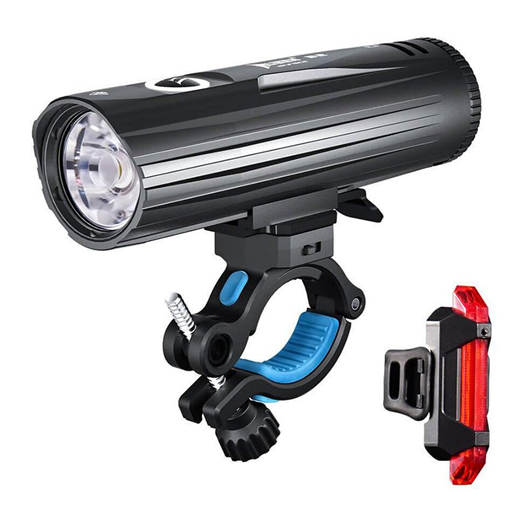When riding a bicycle, visibility and safety are critical. A bright bike light is crucial whether you’re riding your bike around your neighborhood at a leisurely pace, exploring gorgeous trails, or commuting through a busy city. But it can be confusing to choose the best bike light because there are so many variations available. With the aid of this guide, you can go through the many options and choose the ideal bike light for your particular requirements.
Recognizing the Value of Bicycle Lighting
The two main functions of bike lights are to illuminate your path and increase your visibility to others. Having a bike light guarantees that you can see and be seen in low light, which lowers the chance of accidents, especially in the early morning, at dusk, or at night. Bike lights can improve your visibility even during the day, particularly in inclement weather or during periods of high traffic.
many bike light types
Prior to beginning the choosing process, it’s critical to comprehend the many bike light options:
1. Front Lights: Located on the handlebars, front lights guide you through the dark by illuminating the road or trail ahead. They have different brightness levels and beam patterns and are usually brighter than rear lights.
2. Rear Lights: Usually mounted on the seat post, these are mounted to the rear of your bike. The main purpose of rear lights is to increase your visibility to oncoming traffic. Frequently, they have different flashing modes and red LEDs to attract drivers’ attention.
- Combination Sets: Front and rear lights are included in many manufacturers’ combination sets. For individuals who require a comprehensive lighting solution, these sets are a practical choice.
4. Helmet lights: These lights, which are mounted on your helmet, let you see farther and rotate the beam with your head. For off-road and mountain biking, helmet lighting might be especially helpful.
Considerations for Selecting a Bike Light
To make sure you get the best bike light for your needs, take into account the following considerations while making your selection:
Brightness: A key component in deciding how well a light will illuminate your way and make you visible to others is brightness, which is measured in lumens. A brighter light is indicated by higher lumens. Your riding environment will determine how much light is needed. Lower lumen lights may be adequate for well-lit urban areas, but greater lumen lights are needed for darker, unlit routes.
Beam Pattern: The distribution of light is determined by the beam pattern. For off-road and mountain biking, a wide beam pattern lights a greater area, which is advantageous. When road cycling, where seeing farther ahead is essential, a narrow, focussed beam is perfect.
Battery Life: A bike light’s battery life determines how long it can run on a single charge. Take into account how long you usually ride and select a light that has a long enough battery life. While non-rechargeable lights could need regular battery changes, rechargeable lights are more handy and eco-friendly.
Mounting Options: Verify that mounting the light on your bike is simple. The majority of lights include movable mounts that accommodate different handlebar and seat post widths. Additionally, some lights may be installed without the need for a tool, making it simple to add and remove the light as needed.
Weather resistance and durability: Bike lights need to be weather resistant and long-lasting. To make sure your lights will withstand rainy weather, look for ones that are waterproof or constructed of sturdy materials.
Features & Modes: A lot of bike lights include several modes, including strobe, flashing, and steady. These options can improve visibility while preserving battery life. Some lights also have extra features like USB ports for convenient recharging or light sensors that automatically change brightness.
Equipping Your Bike Light with the Right Style for You
Different kinds of bike lights are needed for different riding conditions and styles. Here’s a summary of things to think about in different cycling scenarios:
Urban Commuting: Staying visible to cars and pedestrians is your top priority when traveling through a metropolis. For well-lit streets, a front light with approximately 100–300 lumens is usually adequate. Being more visible can be achieved by having a back light with several flashing modes. To improve your visibility at intersections, think about using lights that provide side vision.
Road riding: A stronger front light, usually between 300 and 1000 lumens, is necessary for road riding, especially at greater speeds, in order to highlight the road ahead. A constant beam makes it easier for you to see, and a flashing rear light makes sure that oncoming vehicles can see you.
Mountain Biking: To illuminate hazards and rough terrain, mountain and off-road bikers need powerful front lights with wide beam patterns. Seek for lighting that has at least 1000 lumens. It can be very helpful to see impending twists and obstacles with a helmet light. Remember to bring a bright rear light so you can be seen by other trail users.
Trail Riding: Trail riding requires a strong front light with a wide beam pattern, much like mountain biking. Complete illumination can be achieved by combining lights mounted on the handlebars with lights mounted on the helmet. Because trails may be hard on equipment, make sure the lights are strong and resistant to the elements.
leisurely Riding: A front light with between 100 and 300 lumens should usually be plenty for leisurely rides in the neighborhood or parks. You can increase your visibility to others by installing a basic back light that has a constant or flashing mode.
Examining Wuben’s Selection of Bicycle Lights
A variety of bike lights are available from Wuben, catering to the various demands of riders. Their lights are renowned for their high caliber, robustness, and cutting-edge features. Here are a few of their most notable products:
Wuben B1: With a maximum brightness output of 1200, this front light is perfect for off-road excursions as well as city driving. It has several brightness settings and a robust, water-resistant design. You can be sure you’re always prepared for your next ride with the USB-C rechargeable battery.
Wuben B2: With its brilliant red LEDs and many flashing settings, this adaptable and stylish rear light offers outstanding visibility. It’s ideal for everyday commutes because it’s long-lasting on batteries and simple to install.
Making the Ultimate Choice
It’s important to take into account your riding style, needs, and the weather while selecting the ideal bike light. You may increase your safety and visibility on the road or trail by choosing a bike light that best suits your needs by being aware of the various kinds available and the important considerations.
Upkeep and Concern Regular upkeep and care are crucial to ensuring your bike lights function at their best and last a long time. To maintain the best possible condition for your lights, follow these tips:
Frequent Cleaning: The buildup of dirt, dust, and moisture on your lights can have an adverse effect on their functionality. Use a gentle cloth and a mild detergent to clean the lenses and housing on a regular basis. Refrain from using anything abrasive that might scratch the lenses.
Battery Maintenance: For rechargeable lights, refer to the charging and maintenance instructions provided by the manufacturer. To keep the battery healthy, avoid overcharging and periodically let it discharge completely. To guarantee consistent functioning, replace batteries in non-rechargeable lights as soon as possible.
Check Mounts: Make sure the straps and mounts are stable and in good shape by checking them on a regular basis. During a ride, the light may shift or fall off due to loose or faulty mounts.
Storage: Keep your bike lights in a dry, cool area when not in use. Refrain from subjecting them to prolonged exposure to intense heat or sunlight.
You can make sure your bike lights work dependably when you need them most by taking proper care of them.
In summary
Understanding the many kinds of bike lights on the market, taking into account the demands of your riding style, and weighing important aspects like brightness, battery life, and durability are all necessary when selecting the finest bike light for your needs. Investing in a high-quality bike light will improve your visibility, safety, and riding enjoyment. Whether you’re riding a bike for fun, navigating mountain trails, or commuting through the city, the correct bike light will make sure you stay visible to other drivers. Invest in a high-quality bike light so you may ride with assurance and assurance that you are ready for any situation.



































